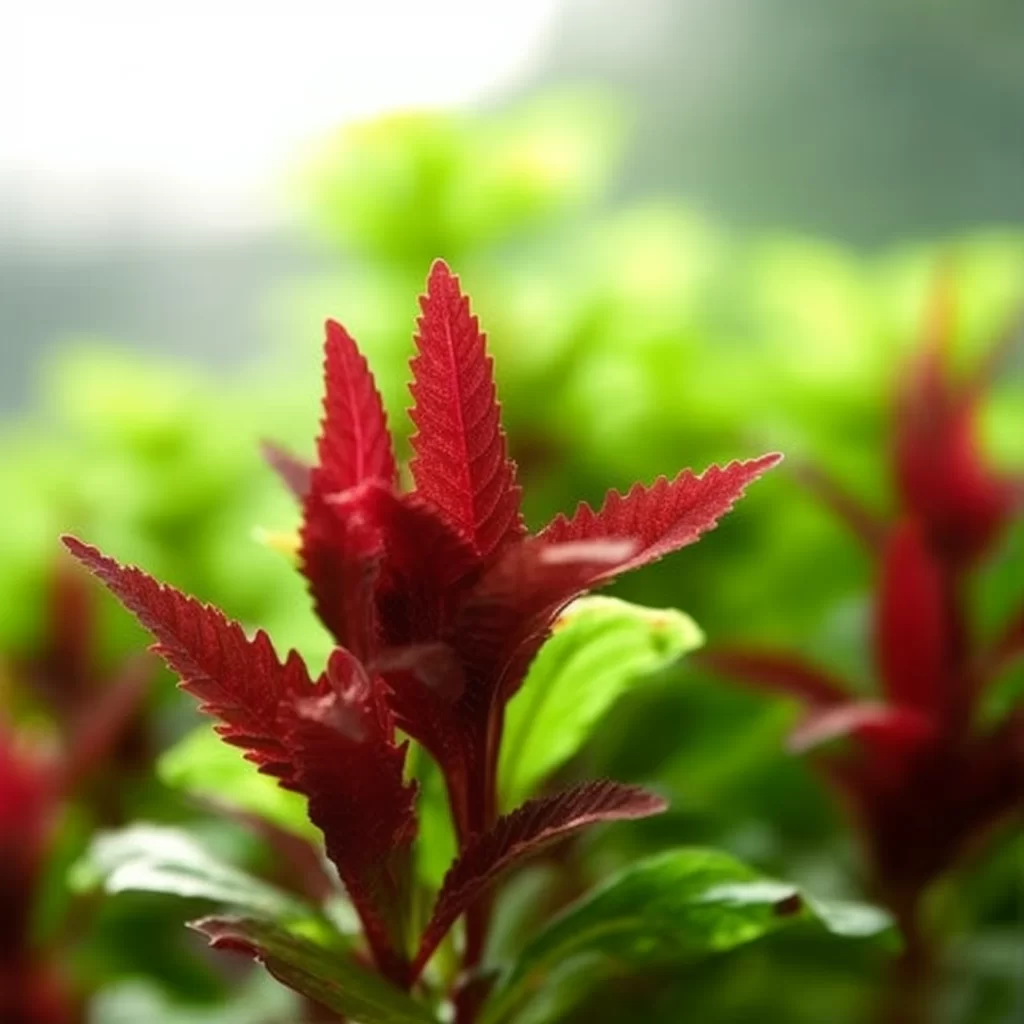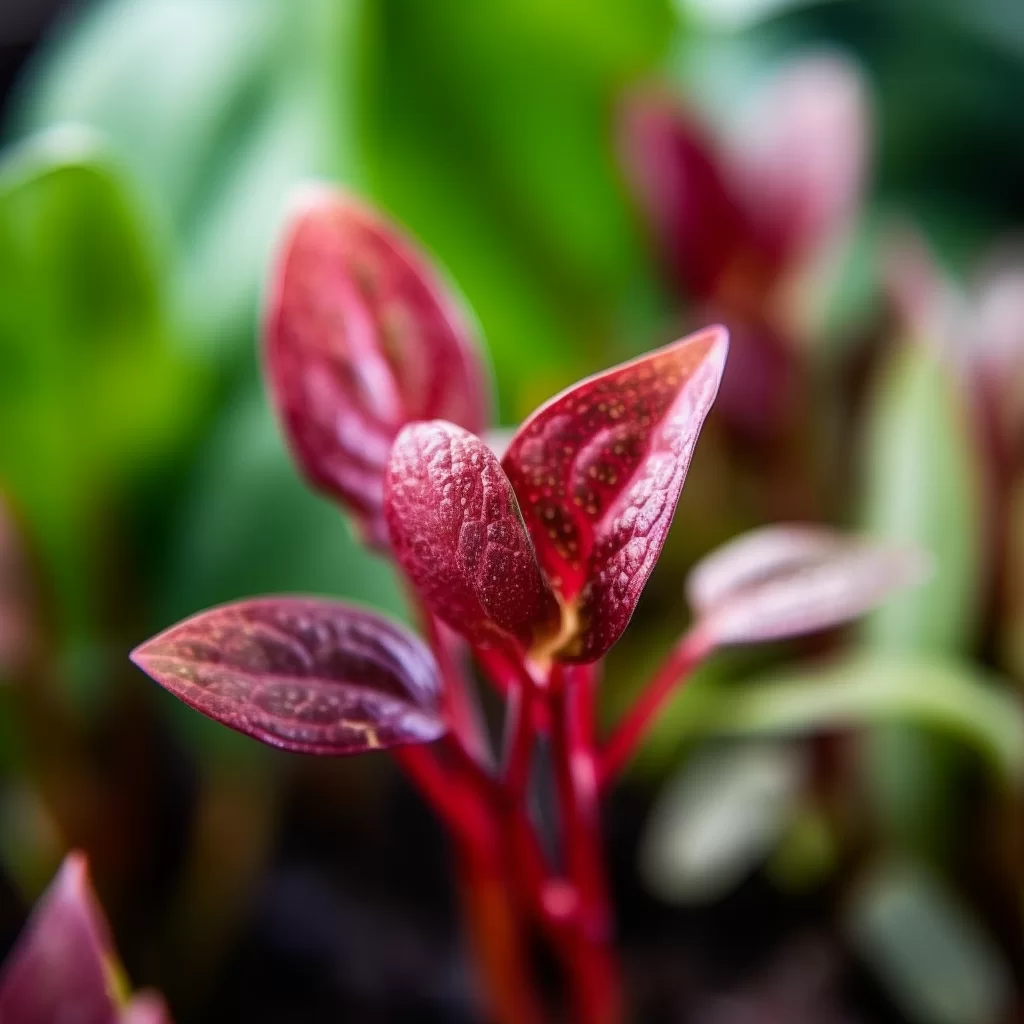Story of Day :
Contents
The Red Shamrock Plant: A Complete Guide and Care Tips
Garden lovers are often drawn to the beauty of the red shamrock plant.
Its stunningly vibrant color and unusual leaves make it a popular choice for those who love to add a little bit of variety and uniqueness to their gardens.
This striking plant is originally from Brazil and belongs to the Oxalis family, which is known for its diverse range of plants.The red shamrock plant goes by several names, such as love plant, purple oxalis, lucky clover, and wood sorrel.
These monikers reflect some of the beliefs people have about this fascinating species.
Some cultures consider it a symbol of good luck while others believe that it has romantic connotations.
Regardless of what you call it or why you grow it, the red shamrock is an excellent addition to any garden that offers both beauty and intrigue with its unique features.
Description of Red Shamrock Plant
- The red shamrock has heart-shaped foliage that comes in shades of deep burgundy or purple-red.
- The leaves have three leaflets per stem that close at night or on cloudy days.
- The flowers are small pink or white starburst-shaped blooms that appear intermittently throughout the year.
- This plant reaches up to eight inches in height and spreads about six inches wide when fully grown.
Where to Grow Red Shamrock Plants?

The red shamrock is a beautiful plant that thrives in outdoor settings, particularly in regions with mild to warm climates.
If you live in the United States, you’ll find that these plants grow best in USDA hardiness zones eight through eleven.
Here, they will enjoy ample sunshine and moderate temperatures that provide them with the ideal environment for growth.But what if you’d like to grow red shamrocks indoors? While they may not be able to bask in direct sunlight all day long, it’s still possible to cultivate them as houseplants if you provide them with bright light conditions.
This can involve placing them near windows or under artificial lighting sources like grow lights.
With proper care and attention, these beautiful plants can flourish indoors just as well as they do outside!
If you’re planning to plant something outdoors, it’s important to choose the right location.
One of the most crucial factors is the soil type.
It’s recommended to look for an area with well-draining soil that also has some organic matter mixed in it.
Why? Well, this combination of features helps retain moisture around the roots while allowing excess water to drain away quickly, ultimately promoting healthy growth and preventing root rot.By selecting appropriate soil conditions when planting outside, you can positively impact your plants’ success rate.
The good news is that ensuring optimal drainage and moisture retention is relatively easy – just choose a well-draining spot with ample organic matter in the soil.
This way, water won’t sit around your plant’s roots and cause damage or mold growth; instead, excess water will drain away quickly while retaining enough moisture for healthy growth over time! If you plan on planting indoors, it’s important to use a potting mix that has proper drainage.
If you plan on planting indoors, it’s important to use a potting mix that has proper drainage.
This will ensure that excess water doesn’t get trapped in the soil, which could lead to waterlogging and ultimately harm your plants.
In addition to using a well-draining potting mix, it’s also essential to choose containers that have drainage holes so water can escape freely from the bottom of the container.
This simple step will help maintain healthy soil and prevent issues with overwatering.Proper drainage is crucial for indoor gardening success.
Without it, your plants may struggle and fail to thrive.
By taking the time to select a good quality potting mix and planting in containers with adequate drainage holes, you can set yourself up for gardening success even when growing indoors!Growing plants from bulbs is an easy and inexpensive way to add some beauty to your home or garden.
You can find a wide variety of bulbs available online or at your local garden center, making it easy to choose the right ones for your space.
Bulbs are also simple to plant and care for, as they require little maintenance once established.
Whether you’re looking to brighten up a dull corner of your house or add some color and texture outdoors, growing plants from bulbs is definitely worth considering.One of the great things about planting bulbs is that you don’t need any special gardening skills.
Simply dig a hole in the ground, pop in the bulb, cover it with soil, and wait for it to bloom! With so many different types of bulbs available – including tulips, daffodils, hyacinths and more – there’s something for every preference.
Plus, buying bulbs online means you have access to even more choices than what might be available locally.
So why not try growing plants from bulbs today? You’ll be amazed at how easy it is!
 Red shamrocks plants, also known as oxalis triangularis, are an attractive and low-maintenance addition to any indoor garden.
Red shamrocks plants, also known as oxalis triangularis, are an attractive and low-maintenance addition to any indoor garden.
To keep your red shamrock healthy and vibrant, it’s essential to provide it with the right care.
Firstly, ensure that your plant gets plenty of indirect sunlight throughout the day as direct sunlight can scorch its leaves.
Watering is also crucial but be sure not to overwater this plant as it can lead to root rot.
Allow the soil to dry out slightly between watering sessions and always water at the base of the plant rather than on top of its leaves.In terms of fertilizer, a balanced houseplant fertilizer is ideal for red shamrocks during their growing season (usually spring through summer).
Reduce watering and avoid fertilizing in winter when growth slows down.
Lastly, keep an eye out for pests such as spider mites or mealybugs which can damage your plant’s foliage.
Regularly inspecting your plant for signs of infestation will help you catch any problems early on and prevent them from spreading further!
- Sunlight: The red shamrock requires bright indirect sunlight (the morning sun exposure for 3-4 hours) daily.
When it comes to watering your plants, consistency is key.
However, you don’t want to overdo it, as this can lead to root rot and ultimately harm the plant.
To avoid this, simply wait until the topsoil feels dry before watering again.
It’s also important to ensure proper drainage by allowing excess water to drain out of bottom holes in your pot or container. Keeping your plants hydrated is crucial for their growth and overall health.
Keeping your plants hydrated is crucial for their growth and overall health.
But did you know that over-watering can be just as harmful as under-watering? To maintain a balance, only water your plants when necessary – typically when the topsoil feels dry.
Don’t forget about proper drainage either! Allowing excess water to escape through bottom holes will help prevent root rot and keep your plant thriving for longer periods of time.To help your plants grow and bloom beautifully, it’s important to give them the nutrients they need.
One way to do this is by using a balanced liquid fertilizer.
This type of fertilizer can be applied once a month during late winter, early spring, and summer months.
By doing so, you’ll be giving your plants the boost they need to thrive.Fertilizing is particularly important during these seasons because this is when most plants are actively growing and flowering.
The nutrients in the liquid fertilizer will help support their growth and ensure that they produce stunning blooms.
Applying the fertilizer once a month should provide enough nourishment for your plants to flourish without overdoing it and harming them with too much chemical exposure.
With regular use of balanced liquid fertilizer, you’ll be able to enjoy healthy and vibrant plant life throughout the year!To ensure the health and beauty of your red shamrock plant, it is important to be mindful of potential pests and diseases that may affect it.
Spider mites, aphids, and mealybugs are common culprits that can infest your plant.
If you spot these pesky creatures on your red shamrock, don’t fret! Simply treat them with insecticidal soap to keep them at bay.It’s also crucial to avoid watering the leaves of your red shamrock as this can create a humid environment where fungus thrives.
This can ultimately lead to leaf spot diseases which will negatively impact the appearance and health of your plant.
To prevent this from happening, focus on watering the soil around the base of the plant instead of directly spraying water onto its leaves.
By taking these steps to protect against pests and diseases, you can help ensure that your red shamrock remains vibrant and healthy for years to come!
Suitable Companions for Red Shamrock Plant
The red shamrock pairs well with other houseplants such as ferns, ivies or snake plants due to its vibrant color, shape of foliage and height difference.
When planted outdoors you can pair them up with other low growing plants such as impatiens or begonias which will complement their height while adding variety of textures in your garden bed.
In Conclusion
The Red Shamrock is an easy-to-maintain plant that adds beauty indoors or outdoors all year round.
With proper care tips above it’s sure that you’ll enjoy watching its colorful foliage grow while brightening up any corner in your home! So don’t hesitate – get yourself some bulbs today!